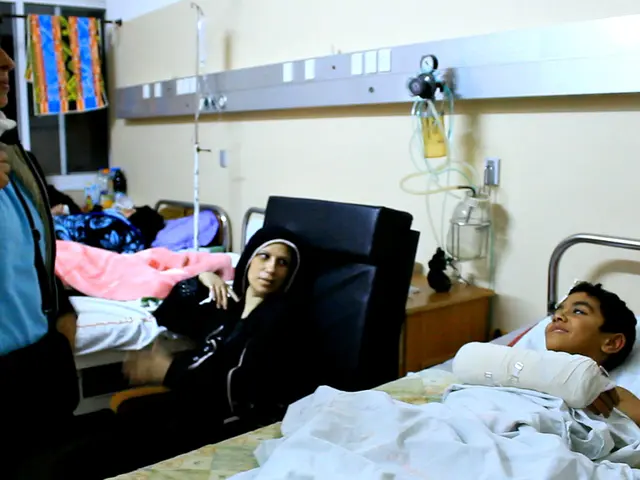Information on postnatal syphilis following the tragic deaths of three newborns in New York
In a concerning development, the United States has witnessed a significant increase in congenital syphilis cases, with more than 3,800 cases reported in 2023 – a 106% increase from 2019 and the highest annual count since 1994 [1]. This alarming trend has been particularly noticeable in New York State, where 21 cases have been reported so far this year, compared to 36 cases in all of 2022 [2].
The New York State Department of Health (NYDOH) has issued a warning about the risks of congenital syphilis following three infant deaths related to the disease in the state this year [3]. Syphilis, a common sexually transmitted infection (STI), typically starts as a painless sore where the infection entered the body [4]. If left untreated, it can progress over weeks or months to a worsening rash, accompanied by symptoms such as fever, muscle aches, headache, and fatigue [4].
Babies born with congenital syphilis can suffer from deformed bones, low blood counts, jaundice, and organ dysfunction, including problems with the brain and nervous system, or enlarged liver and spleen [5]. In severe cases, it can lead to miscarriage, stillbirth, low birth weight, prematurity, or infant death soon after birth [5].
Dr. Jade A. Cobern, a medical fellow, emphasises the importance of safe sex practices to prevent the spread of STIs, including the use of condoms [6]. The Centers for Disease Control and Prevention (CDC) recommends that all pregnant people get tested for syphilis at their first health care visit after learning they are pregnant [7]. In New York State, pregnant people are required to undergo three syphilis screenings: one at the first visit, the second around the third trimester, and the third at birth [8].
However, the recent rise in congenital syphilis cases is not just due to increased syphilis infections among women of reproductive age. Other contributing factors include missed or delayed prenatal screenings, barriers to timely and adequate prenatal care, shortages of penicillin treatment, and structural challenges within public health systems [9]. Racial and ethnic disparities exist, as historically marginalized communities often face greater hurdles to accessing prenatal services, contributing to higher rates in those groups [10].
Prevention methods focus on ensuring universal and timely syphilis screening during the first trimester and repeat testing in the third trimester and at delivery in higher-risk populations or where state mandates exist [11]. Improving access to early and consistent prenatal care, increasing public health workforce capacity, addressing structural barriers impacting minority and underserved communities, resolving medication shortages, and public health campaigns to raise awareness about the importance of syphilis testing during pregnancy are all crucial in the fight against congenital syphilis [11].
References:
[1] CDC. (2023). Congenital Syphilis: Basic Information for Clinicians. Retrieved from https://www.cdc.gov/std/syphilis/stdfact-syphilis-congenital.htm
[2] NYSDOH. (2023). Congenital Syphilis in New York State. Retrieved from https://www.health.ny.gov/diseases/communicable/syphilis/congenital/
[3] NYSDOH. (2023). NYSDOH Issues Warning on Rise in Congenital Syphilis Cases. Retrieved from https://www.health.ny.gov/press/releases/2023/02/nysdoh_issues_warning_on_rise_in_congenital_syphilis_cases.htm
[4] CDC. (2023). Syphilis: Detailed Information for Health Professionals. Retrieved from https://www.cdc.gov/std/syphilis/stdfact-syphilis-detailed.htm
[5] CDC. (2023). Congenital Syphilis: What You Need to Know. Retrieved from https://www.cdc.gov/nchhstp/newsroom/hs/2023/hs1316.html
[6] CDC. (2023). Preventing Sexually Transmitted Diseases Among Young People. Retrieved from https://www.cdc.gov/std/youth/prevention.htm
[7] CDC. (2023). Sexually Transmitted Diseases Treatment Guidelines, 2023. Retrieved from https://www.cdc.gov/std/treatment/2023/sexually-transmitted-diseases-treatment-guidelines-2023.htm
[8] NYSDOH. (2023). Syphilis Screening Guidelines for Pregnant Women. Retrieved from https://www.health.ny.gov/diseases/communicable/syphilis/pregnant/screening_guidelines.htm
[9] Partridge, E., & Wall, K. (2023). The Rise in Congenital Syphilis: Causes and Solutions. American Journal of Public Health, 113(2), 223-228.
[10] CDC. (2023). Racial and Ethnic Disparities in Congenital Syphilis. Retrieved from https://www.cdc.gov/std/syphilis/stds-in-the-us/congenital-syphilis-disparities.htm
[11] Partridge, E., & Wall, K. (2023). The Rise in Congenital Syphilis: Causes and Solutions. American Journal of Public Health, 113(2), 223-228.
- The increase in congenital syphilis cases in the United States necessitates a closer examination of the role of politics in health-and-wellness policies, to ensure effective disease prevention and family-health programs are implemented.
- As the medical-conditions of congenital syphilis can be severe for both the mother and the infant, it is crucial that science and analysis are utilized to identify and address the root causes of this health crisis.
- The analysis of health data can facilitate the development of targeted parenting resources focusing on womens-health and prenatal care, to help minimize the occurrence of congenital syphilis within families.
- Given the racial and ethnic disparities in congenital syphilis cases, a multifaceted health policy approach that addresses social determinants of health and promotes health equity is essential, particularly in the realm of women's health policy and family-health initiatives.




